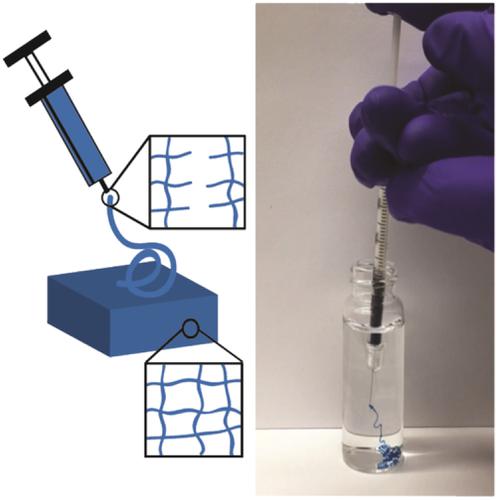当前位置:
X-MOL 学术
›
J. Appl. Polym. Sci.
›
论文详情
Our official English website, www.x-mol.net, welcomes your feedback! (Note: you will need to create a separate account there.)
Recent advances in shear‐thinning and self‐healing hydrogels for biomedical applications
Journal of Applied Polymer Science ( IF 3 ) Pub Date : 2019-11-07 , DOI: 10.1002/app.48668 Selen Uman 1 , Abhishek Dhand 2 , Jason A. Burdick 1
Journal of Applied Polymer Science ( IF 3 ) Pub Date : 2019-11-07 , DOI: 10.1002/app.48668 Selen Uman 1 , Abhishek Dhand 2 , Jason A. Burdick 1
Affiliation

|
Shear‐thinning and self‐healing hydrogels are being investigated in various biomedical applications including drug delivery, tissue engineering, and 3D bioprinting. Such hydrogels are formed through dynamic and reversible interactions between polymers or polypeptides that allow these shear‐thinning and self‐healing properties, including physical associations (e.g., hydrogen bonds, guest–host interactions, biorecognition motifs, hydrophobicity, electrostatics, and metal–ligand coordination) and dynamic covalent chemistry (e.g., Schiff base, oxime chemistry, disulfide bonds, and reversible Diels–Alder). Their shear‐thinning properties allow for injectability, as the hydrogel exhibits viscous flow under shear, and their self‐healing nature allows for stabilization when shear is removed. Hydrogels can be formulated as uniform polymer and polypeptide assemblies, as hydrogel nanocomposites, or in granular hydrogel form. This review focuses on recent advances in shear‐thinning and self‐healing hydrogels that are promising for biomedical applications. © 2019 Wiley Periodicals, Inc. J. Appl. Polym. Sci. 2020, 137, 48668.
中文翻译:

用于生物医学应用的剪切稀化和自修复水凝胶的最新进展
剪切稀化和自修复水凝胶正在各种生物医学应用中进行研究,包括药物输送,组织工程和3D生物打印。此类水凝胶是通过聚合物或多肽之间的动态和可逆相互作用形成的,这些相互作用允许这些剪切稀化和自我修复特性,包括物理缔合(例如,氢键,客体-主体相互作用,生物识别基序,疏水性,静电和金属-配体)配位)和动态共价化学(例如席夫碱,肟化学,二硫键和可逆Diels–Alder)。它们的剪切稀化特性使之具有可注射性,因为水凝胶在剪切作用下表现出粘性流动,而它们的自我修复特性使去除剪切时的稳定性得以保持。可以将水凝胶配制成均匀的聚合物和多肽组件,水凝胶纳米复合材料或颗粒状水凝胶形式。这篇综述着重于在剪切稀化和自修复水凝胶方面的最新进展,这些进展对于生物医学应用是有前途的。分级为4 +©2019 Wiley Periodicals,Inc.J.Appl。Polym。科学2020,137,48668。
更新日期:2020-03-26
中文翻译:

用于生物医学应用的剪切稀化和自修复水凝胶的最新进展
剪切稀化和自修复水凝胶正在各种生物医学应用中进行研究,包括药物输送,组织工程和3D生物打印。此类水凝胶是通过聚合物或多肽之间的动态和可逆相互作用形成的,这些相互作用允许这些剪切稀化和自我修复特性,包括物理缔合(例如,氢键,客体-主体相互作用,生物识别基序,疏水性,静电和金属-配体)配位)和动态共价化学(例如席夫碱,肟化学,二硫键和可逆Diels–Alder)。它们的剪切稀化特性使之具有可注射性,因为水凝胶在剪切作用下表现出粘性流动,而它们的自我修复特性使去除剪切时的稳定性得以保持。可以将水凝胶配制成均匀的聚合物和多肽组件,水凝胶纳米复合材料或颗粒状水凝胶形式。这篇综述着重于在剪切稀化和自修复水凝胶方面的最新进展,这些进展对于生物医学应用是有前途的。分级为4 +©2019 Wiley Periodicals,Inc.J.Appl。Polym。科学2020,137,48668。


























 京公网安备 11010802027423号
京公网安备 11010802027423号